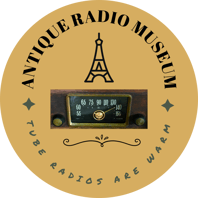CONSOLE RADIO PAGE
This page will show some of the console radios I have.
I have not added many of these to my collection due to the fact that they take up too much space (both vertical and horizontal), and space is always at a premium.
For definition's sake, a console radio is one that is considered a floor model and is like a piece of furniture. In some cases the cabinet were made by specialty furniture companies and originally cost much more than the radio that was installed inside of it and today these cabinets are valued by antique furniture collectors regardless of what is inside of them.
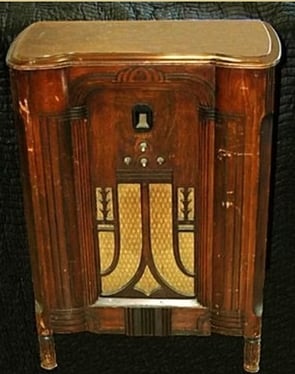

This is a fairly rare Philco Type 89 Lowboy console made in 1933.
I just received this set as a donation to the museum from W0BXS.....tnx Don.
I just picked up this set today (3/15/2006) so I can't tell you much about it other than the cabinet is very solid, with no veneer delaminations and no cabinet separations. The grill cloth seems in very good shape and the cabinet has the usual nicks and scratches, but it is VERY restorable. A visual check of the speaker says it looks really good, but at the age of this set (73 years old) the speaker cone may just crumble when I touch it. All tubes are present, but will need to be checked before trying to power this up.
I'll update this paragraph as I get into this beauty! Again, thanks to W0BXS for the donation. See pg. 64 of Ron Ramirez's book "Philco Radio, 1928-1942" for a similar photo. I might even say that this set looks better than the one in the book.
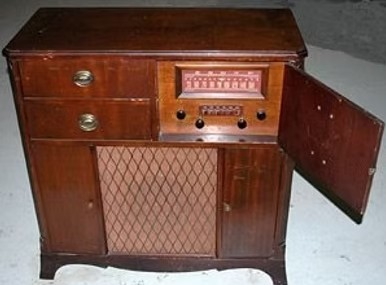

Stewart-Warner model 9004-G
This radio has AM and Shortwave and a single speed record player. The only info I could find on the date so far is that it was made pre-1948. This radio was donated to the museum by Les Foster via AE6C. Thanks Les.

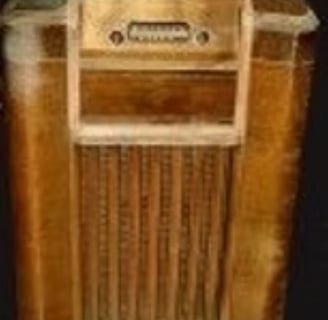
PHILCO A-361 FROM 1941/42
This is a somewhat unusual radio that was made by Philco in 1942, just before, or concurrent with switching over to war production.
This is model A-361 and the unusual thing is that it has a car radio chassis installed in the cabinet. The car radio has been converted to work on AC, but I don't see any external transformer or power supply. I have not opened up the chassis to see how it was done.
This radio was donated to the museum by Tom Albrecht, a member of CHRS. Thanks Tom.
Here is the "car radio" chassis that is installed in this console. The AC wires go straight into the set. Another set of wires go to the speaker (plug in) and there is an antenna wire.
It is believed that when Philco switched over to war time production they had these car radio chassis with no home so they used up their inventory in this way. Remember, all the auto manufacturers also had switched to military vehicle production so there was no market for car radios during those years.
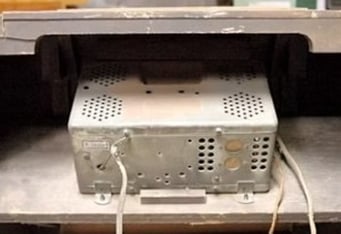

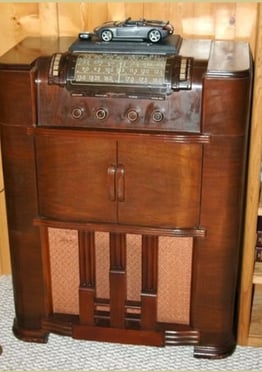

ADMIRAL 6C71 FROM 1946
This is an Admiral model 6C71 from 1946. It is a combination radio/phonograph. As you can see it has 4 bands across the dial face. These include one for standard broadcast. One for the 49 meter section from 5.5 - 7.5 MC. Then one for the 31-25 meter band from 9.0 - 12.5 MC. And, finally, one for the 19-16 meter band from 15.0 to 18.0 MC.
On the left side are push buttons for adjusting the tone of the audio. These are labeled as Voice, Normal, Music, Alto, and Bass.
On the right side are some push buttons for specific stations and these are labeled WMCA, WEAF, WOR, WJZ, and WABC. Note that these are all east coast stations.
For those who don't know, in general stations to the east of the Mississippi River start with the letter "W" and those to the west of the river start with the letter "K". There are just a few exceptions to that rule and those are old stations who had their call sign before this rule was developed.
I saw an advertisement for this radio and because all the radios from the 20's and 30's had tiny dial faces, this one was advertised as having a NO STOOP, NO SQUINT, dial.....hahaha.
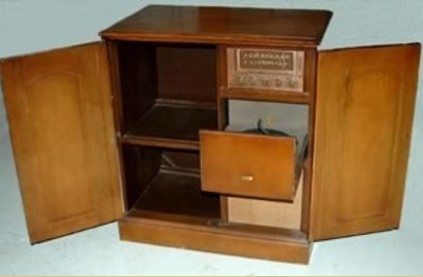

MAGNAVOX 477P RADIO/PHONO
This is a Magnavox AM/FM Radio/Phono model 477P from 1950. I saw an ad for this radio and it said that it was possible to add a 16" rectangular TV to the upper left side of the cabinet. There is an input on the back of the radio labeled "TV" so that the audio from the TV could use the audio amplifier and speaker of the radio. Remember that a "round" screen was the norm in 1950 so to be able to advertise a rectangular screen was a big competitive advantage.
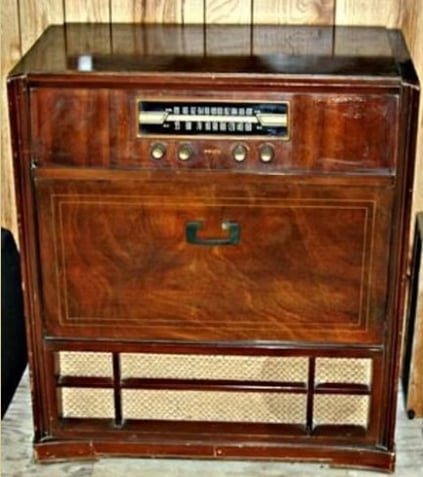

PHILCO 50-1725 RADIO/PHONO FROM 1950
The picture makes this set from 1950 look a lot nicer than it is. This is a Philco 50-1725 radio/phono console. When you pull down on the door handle in the middle a phonograph slides out. The radio is an AM/FM model with 7 tubes.
Imagine, the modern boom boxes have 150 plus watts of audio output power and this big radio boasted of its 5 watts of audio output! Times sure have changed.
Notice that the turntable has two arms on it. I have learned that the larger arm was for the 78 RPM records and the smaller arm was for the 33 1/3 LP records.
There is a switch just to the right of the changer that switches from STD to LP, which tells us that in 1950 the 78 RPM records were "standard" and the 33 1/3 LP were the "new fangled" things.
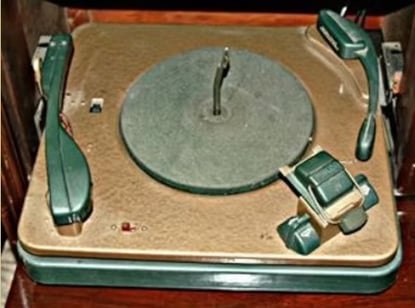

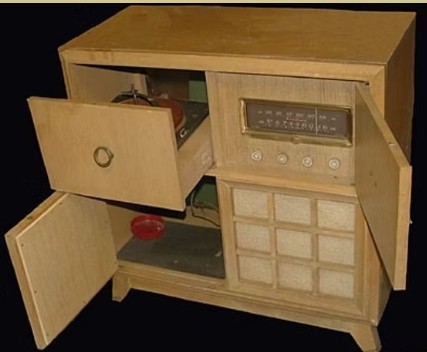

AIRLINE AM/FM BLONDE CONSOLE
This is a nice Airline (Montgomery Wards) AM-FM-Phono console from about 1957.
This blonde finish was popular during that era and when this is closed up it looks like a nice side table piece of furniture. The cabinet needs refinishing and the radio needs work, but all the tubes are there and it doesn't smoke when you plug it in....so that is a good start!
This radio was donated to the museum by Mrs. Teresa Humble who says of the radio: "The console was my parents, Ltc. Robert H. McCauley and Mrs. Louise E. Duecker McCauley. It provided our family with many years of listening to wonderful music and radio shows together."
Also my thanks to Adam Peters for pointing Teresa our direction.
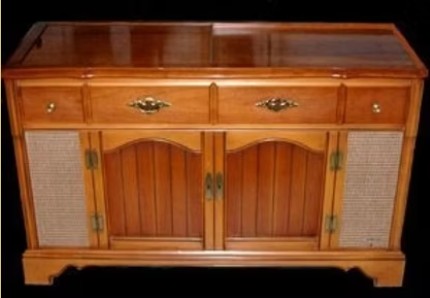

EARLY SOLID STATE MAGNAVOX STEREO
This beautiful AM/FM stereo radio/record player combination was purchased in 1965 by Les Foster, who donated this system to the museum. Thanks Les.
Les paid $410 "out the door" for this system and I would guess he got many years of pleasure out of it. You can see that it is a beautiful piece of furniture even without considering the radio.
The doors on the bottom are fake, including the hinges. Well, the hinges are REAL, but they don't serve a function. The record player and AM/FM radio is under a sliding tray on the top right of the radio and under the top left sliding tray is a record storage compartment and a switch for selecting either the internal speakers, or external speakers.
